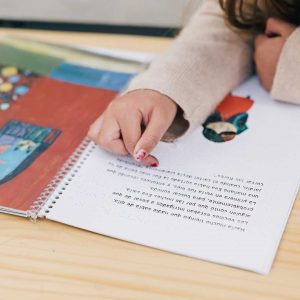Of course, in order to effectively teach your children reading, you need to know where to start. To start, it helps if you can identify their reading levels. This is so that you can challenge them while avoiding the frustration that results when reading material is too difficult. A reading level assessment may be just what you need. However, you may ask, “How can I test my children’s reading levels at home?” But don’t worry. In fact, we have many resources to help you solve the reading-level mystery can boost your success as a homeschooler.
Doing A Reading Level Assessment at Home
Have you wondered what your child’s reading level is? Thought about a reading level assessment?
Actually, one quick way of assessing reading grade levels is to look at the reading levels of their favorite books. In fact, this is usually located near the list price on the back cover. You’ll see something like this: RL 3.2. This means that the book contains the reading vocabulary of a typical child in the second month of the third grade.
However, it isn’t a perfect measurement. Additionally, these ratings rarely go above a 6th-grade level. However, knowing an average of the RL’s of your children’s favorite books is only a start. It can give you a rough estimate of where your children read comfortably.
In fact, to discover how comfortable each child is with a particular reading level, you can also do a simplified version of what reading teachers refer to as “running records.” First, photocopy a bit of text that is at the level you think your child is reading. Next, have your child read aloud and mark where your child makes reading errors. Then try to identify the types of errors your child is making, so you can think about strategies. Also, consider audio recording your child’s reading. Save the recordings by date so you can more easily assess improvements and—most importantly—so you can share and celebrate your child’s progress!
Truly, it’s good to pay attention when your children read. Do you notice if they are struggling or reading easily? Can you ask if they are enjoying their reading and if they can “see” what they are reading? It’s important to watch for skipping lines and excessive re-reading as well as regular eye doctor checkups. Another thing you can do is to check for understanding and vocabulary. Ask your children to summarize what they have read. The more you communicate with your children about what they are reading, the more you will know about their reading levels.
Free Reading Level Assessment Tests to Determine a Child’s Reading Level
While informal reading assessment can be valuable, what if you want to identify a certain reading level to set a benchmark? Write annual goals? Track progress, or determine whether goals have been met? Indeed, wouldn’t you love to find a reading level test online? We can help! Below are some free online reading level tests and reading level assessments. Parents can use to better understand the reading levels of their children:
- English Club: Test Your English Reading Level: “This test evaluates how well you understand what you read in English. It is strictly called a Written Comprehension Test because it shows how well you comprehend what somebody writes. You have 15 minutes to do this test. You must stop after 15 minutes and press the “Your Score Is…” button. There are 20 questions.”
- Free Reading Speed Test: “Quickly determine your reading speed and comprehension using themed and leveled reading comprehension tests.”
- Pioneer Valley Books: Leveled Reading Assessment: “Our simple tool provides an online opportunity to assess your students’ reading level…. The Leveled Reading Assessment (LRA) is designed to help teachers select books at the appropriate reading level that will help their students grow as readers and thinkers. This assessment is designed for students reading Kindergarten through Grade 7; however, it can also be used with older students who may be struggling to learn to read at a certain level.”
- Schonell Reading Test: The Schonell Reading Test determines reading age, not reading grade level. Students read a list of words and get one point for each word they correctly pronounce. Then determine the reading age by a formula based on the number of words correct.
Reading Level Assessment Resources
Want more reading level assessment help? We have some resources listed below to help you find something to fit your needs.
- Assessment for Reading Instruction, Fourth Edition by Katherine A. Dougherty Stahl, Ed.D., Kevin Flanigan, Ph.D., and Michael C. McKenna, Ph.D.: “The book explains how to use both formal and informal assessments to evaluate students’ strengths and needs in all components of reading. ”
- DIBELS 8th Edition: “DIBELS 8th Edition is a battery of short (one minute) fluency measures that can be used for universal screening, benchmark assessment, and progress monitoring in Kindergarten – 8th grade.” Download the free testing materials and watch for (sometimes free) webinars and training videos.
 Guide to Reading Levels: Demystifying computerized reading programs: “By now, we’ve gotten used to the idea that many children’s books identify a Reading Level (RL) somewhere on the jacket or back cover. This number is handy for parents and children’s librarians trying to find books of an appropriate comprehension level for young readers. But where did the number come from?”
Guide to Reading Levels: Demystifying computerized reading programs: “By now, we’ve gotten used to the idea that many children’s books identify a Reading Level (RL) somewhere on the jacket or back cover. This number is handy for parents and children’s librarians trying to find books of an appropriate comprehension level for young readers. But where did the number come from?”
- K5 Reading and Math Assessment: “As part of our free 14-day trial, your child will receive: a free online reading assessment, a free online math assessment, and access to our complete program including K5 Reading, K5 Math and K5 Spelling…. No credit card required.”
- Reading A-Z: Assessing a Student’s Level: “A three-part assessment process to help you place students in instructional appropriate level texts. Find out at which level to start a student. Determine when a student is ready to move to the next level.” You need to be a member to access this benchmark assessment, but there is a free 14-day trial.
- Reading Assessment Techniques (SEDL): “We have created this summary of the different types of assessments that can be used for measuring development in reading skills in the hopes that teachers will better understand how single skills can be assessed by multiple measures.”
Reading Assessment, Third Edition: A Primer for Teachers in the Common Core Era (Solving Problems in the Teaching of Literacy) by JoAnne Schudt Caldwell, Ph.D.: “This trusted practitioner guide and course text help K-8 teachers utilize assessment as an integral component of classroom instruction. It guides teachers step by step to recognize good reader behaviors, assess students’ strengths and weaknesses, and make evidence-based instructional decisions.”
- Sound Reading Solutions: Free Reading Assessment: Sound Reading’s Assessment is free and only takes 3 minutes.” You do need to enter your name, email, student’s name, age, and grade in order to access the assessment.
- The SMOG Readability Formula: “SMOG Readability Formula estimates the years of education a person needs to understand a piece of writing. McLaughlin created this formula as an improvement over other readability formulas.”
Additional Homeschool Reading Resources
How to Improve Your Child’s Reading Skills
Teaching Reading Strategies and Engaging your Reluctant Readers
Top 5 Mistakes in Teaching Children to Read




